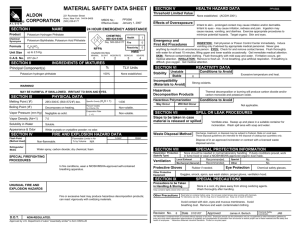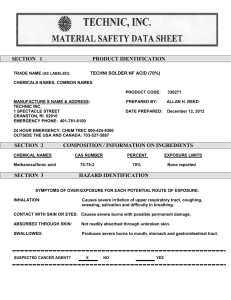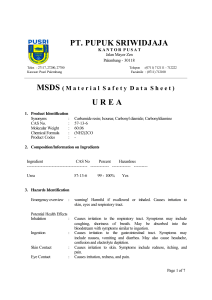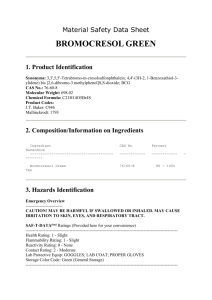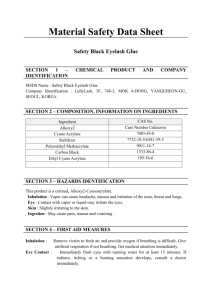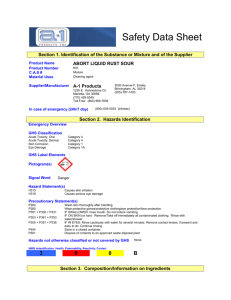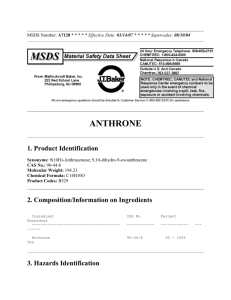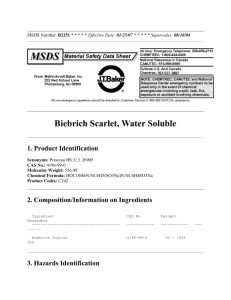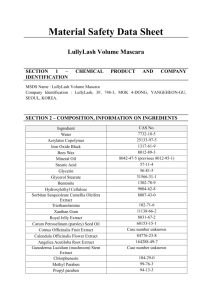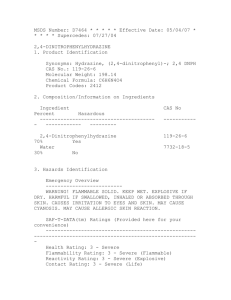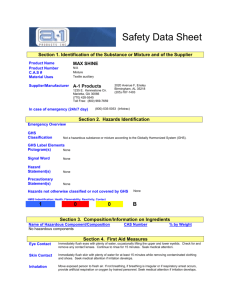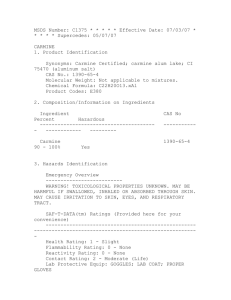ammonium sulfate - IndianaChem-Port
advertisement
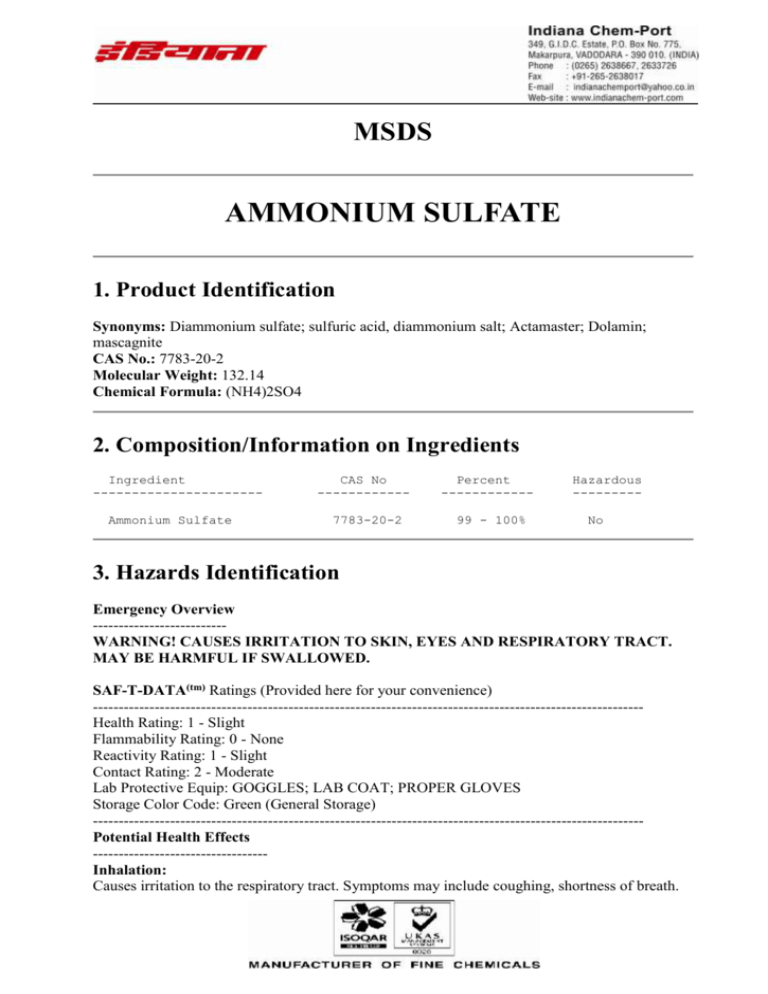
MSDS AMMONIUM SULFATE 1. Product Identification Synonyms: Diammonium sulfate; sulfuric acid, diammonium salt; Actamaster; Dolamin; mascagnite CAS No.: 7783-20-2 Molecular Weight: 132.14 Chemical Formula: (NH4)2SO4 2. Composition/Information on Ingredients Ingredient ---------------------Ammonium Sulfate CAS No -----------7783-20-2 Percent -----------99 - 100% Hazardous --------No 3. Hazards Identification Emergency Overview -------------------------WARNING! CAUSES IRRITATION TO SKIN, EYES AND RESPIRATORY TRACT. MAY BE HARMFUL IF SWALLOWED. SAF-T-DATA(tm) Ratings (Provided here for your convenience) ----------------------------------------------------------------------------------------------------------Health Rating: 1 - Slight Flammability Rating: 0 - None Reactivity Rating: 1 - Slight Contact Rating: 2 - Moderate Lab Protective Equip: GOGGLES; LAB COAT; PROPER GLOVES Storage Color Code: Green (General Storage) ----------------------------------------------------------------------------------------------------------Potential Health Effects ---------------------------------Inhalation: Causes irritation to the respiratory tract. Symptoms may include coughing, shortness of breath. Ingestion: Causes irritation to the gastrointestinal tract. Symptoms may include nausea, vomiting and diarrhea. It presents little toxicity unless large amounts are ingested, in which case, vomiting and diarrhea are likely. Skin Contact: Causes irritation to skin. Symptoms include redness, itching, and pain. Eye Contact: Causes irritation, redness, and pain. Chronic Exposure: No information found. Aggravation of Pre-existing Conditions: No information found. 4. First Aid Measures Inhalation: Remove to fresh air. If not breathing, give artificial respiration. If breathing is difficult, give oxygen. Get medical attention. Ingestion: Induce vomiting immediately as directed by medical personnel. Never give anything by mouth to an unconscious person. Get medical attention. Skin Contact: Immediately flush skin with plenty of water for at least 15 minutes. Remove contaminated clothing and shoes. Get medical attention. Wash clothing before reuse. Thoroughly clean shoes before reuse. Eye Contact: Immediately flush eyes with plenty of water for at least 15 minutes, lifting upper and lower eyelids occasionally. Get medical attention. 5. Fire Fighting Measures Fire: Not considered to be a fire hazard. Flammable ammonia gas may be released in a fire. Explosion: May explode if mixed with oxidizers, such as potassium nitrate, potassium nitrite, and potassium chlorate. Fire Extinguishing Media: Use any means suitable for extinguishing surrounding fire. Water spray may be used to keep fire exposed containers cool. Special Information: In the event of a fire, wear full protective clothing and NIOSH-approved self-contained breathing apparatus with full facepiece operated in the pressure demand or other positive pressure mode. 6. Accidental Release Measures Ventilate area of leak or spill. Wear appropriate personal protective equipment as specified in Section 8. Spills: Sweep up and containerize for reclamation or disposal. Vacuuming or wet sweeping may be used to avoid dust dispersal. 7. Handling and Storage Keep in a tightly closed container, stored in a cool, dry, ventilated area. Protect against physical damage. Isolate from incompatible substances. Containers of this material may be hazardous when empty since they retain product residues (dust, solids); observe all warnings and precautions listed for the product. 8. Exposure Controls/Personal Protection Airborne Exposure Limits: None established. Ventilation System: A system of local and/or general exhaust is recommended to keep employee exposures as low as possible. Local exhaust ventilation is generally preferred because it can control the emissions of the contaminant at its source, preventing dispersion of it into the general work area. Please refer to the ACGIH document, Industrial Ventilation, A Manual of Recommended Practices, most recent edition, for details. Personal Respirators (NIOSH Approved): For conditions of use where exposure to dust or mist is apparent and engineering controls are not feasible, a particulate respirator (NIOSH type N95 or better filters) may be worn. If oil particles (e.g. lubricants, cutting fluids, glycerine, etc.) are present, use a NIOSH type R or P filter. For emergencies or instances where the exposure levels are not known, use a full-face positivepressure, air-supplied respirator. WARNING: Air-purifying respirators do not protect workers in oxygen-deficient atmospheres. Skin Protection: Wear impervious protective clothing, including boots, gloves, lab coat, apron or coveralls, as appropriate, to prevent skin contact. Eye Protection: Use chemical safety goggles and/or full face shield where dusting or splashing of solutions is possible. Maintain eye wash fountain and quick-drench facilities in work area. 9. Physical and Chemical Properties Appearance: Fine white granules or crystals. Odor: Slight odor of ammonia. Solubility: Appreciable in water. 41.22 g/100 g water @ 25C (77F) Density: 1.77 @ 50C(122F) pH: 5.5 (0.1M aqueous solution) % Volatiles by volume @ 21C (70F): 0 Boiling Point: Not applicable. Melting Point: 235 - 280C (455 - 536F) Decomposes. Vapor Density (Air=1): No information found. Vapor Pressure (mm Hg): No information found. Evaporation Rate (BuAc=1): No information found. 10. Stability and Reactivity Stability: Stable under ordinary conditions of use and storage. Maintain at temperatures below 513C (955F). Hazardous Decomposition Products: May emit ammonia, oxides of sulfur, oxides of nitrogen, and oxides of carbon. Hazardous Polymerization: Will not occur. Incompatibilities: Sodium hypochlorite, potassium plus ammonium nitrate, potassium chlorate, potassium nitrite, and sodium-potassium powder plus ammonium nitrate, and other strong oxidizers. Conditions to Avoid: Heat, incompatibles. 11. Toxicological Information Investigated as a mutagen. --------\Cancer Lists\-------------------------------------------------------NTP Carcinogen--Ingredient Known Anticipated IARC category --------------------------------------------------------Ammonium Sulfate (7783-20-2) No No None 12. Ecological Information Environmental Fate: No information found. Environmental Toxicity: No information found. 13. Disposal Considerations Whatever cannot be saved for recovery or recycling should be managed in an appropriate and approved waste disposal facility. Processing, use or contamination of this product may change the waste management options. State and local disposal regulations may differ from federal disposal regulations. Dispose of container and unused contents in accordance with federal, state and local requirements. 14. Transport Information Not regulated. 15. Regulatory Information Not regulated. 16. Other Information NFPA Ratings: Health: 2 Flammability: 0 Reactivity: 0 Label Hazard Warning: WARNING! CAUSES IRRITATION TO SKIN, EYES AND RESPIRATORY TRACT. MAY BE HARMFUL IF SWALLOWED. Label Precautions: Avoid contact with eyes, skin and clothing. Wash thoroughly after handling. Avoid breathing dust. Keep container closed. Use only with adequate ventilation. Label First Aid: In case of contact, immediately flush eyes or skin with plenty of water for at least 15 minutes. Remove contaminated clothing and shoes. Wash clothing before reuse. If inhaled, remove to fresh air. If not breathing, give artificial respiration. If breathing is difficult, give oxygen. If swallowed, induce vomiting immediately as directed by medical personnel. Never give anything by mouth to an unconscious person. In all cases, get medical attention. Product Use: Laboratory Reagent. Revision Information: MSDS Section(s) changed since last revision of document include: 3. Disclaimer: ***************************************************************************** INDIANA CHEM-PORT, provides the information contained herein in good faith but makes no representation as to its comprehensiveness or accuracy. This document is intended only as a guide to the appropriate precautionary handling of the material by a properly trained person using this product. Individuals receiving the information must exercise their independent judgment in determining its appropriateness for a particular purpose. *****************************************************************************
